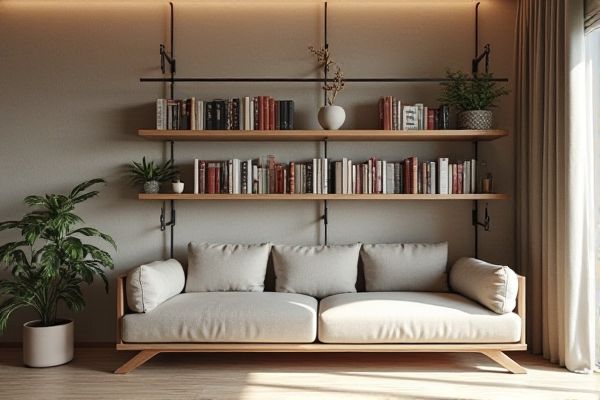
Minimal bookshelves focus on functionality with clean lines and limited ornamentation, offering a sleek and organized way to store your books. Decorative bookshelves prioritize aesthetic appeal, often featuring intricate designs and embellishments to complement your interior decor; explore the rest of this article to discover which style best suits your needs and space.
Table of Comparison
| Feature | Minimal Bookshelf | Decorative Bookshelf |
|---|---|---|
| Design Style | Simple, clean lines, functional | Ornate, artistic, visually appealing |
| Material | Wood, metal, often unembellished | Wood, metal, glass, with decorative finishes |
| Purpose | Storage and organization | Display and aesthetic enhancement |
| Size | Compact, space-efficient | Varied sizes, often larger |
| Price Range | Affordable to mid-range | Mid-range to high-end |
| Target Audience | Minimalists, practical users | Decor enthusiasts, designers |
| Maintenance | Low maintenance | May require regular cleaning and upkeep |
Introduction to Minimal vs Decorative Bookshelves
Minimal bookshelves emphasize clean lines, functional design, and space efficiency, making them ideal for modern, clutter-free interiors. Decorative bookshelves prioritize aesthetic appeal and unique shapes, often serving as statement pieces that enhance the room's visual interest. Selecting between minimal and decorative styles depends on balancing practicality with the desired artistic impact in a living space.
Defining Minimal Bookshelves
Minimal bookshelves emphasize clean lines, functionality, and simplicity, often featuring neutral colors and open designs to avoid visual clutter. Unlike decorative bookshelves, which prioritize ornamental elements and intricate details, minimal bookshelves focus on maximizing storage efficiency while maintaining an understated aesthetic. This design approach supports modern interiors by highlighting book collections without overwhelming the surrounding space.
Key Features of Decorative Bookshelves
Decorative bookshelves prioritize aesthetic appeal by combining functional storage with artistic design elements such as intricate carvings, vibrant colors, and unique shapes. Unlike minimal bookshelves that emphasize simplicity and clean lines, decorative options often serve as focal points in a room, showcasing your personal style while organizing books and collectibles. These shelves typically incorporate diverse materials like glass, metal, or reclaimed wood to enhance visual interest and complement your interior decor.
Aesthetic Appeal: Simplicity vs Ornamentation
Minimal bookshelves emphasize clean lines and simplicity, promoting a sleek and uncluttered aesthetic that complements modern and contemporary interiors. Decorative bookshelves feature intricate designs, embellishments, and varied materials, adding character and visual interest to a space. The choice between minimal and decorative styles depends on whether the goal is understated elegance or expressive ornamentation.
Space Optimization and Functionality
Minimal bookshelves maximize space optimization by featuring streamlined designs that fit seamlessly into small areas, enhancing your room's functionality with clean lines and efficient storage. Decorative bookshelves prioritize aesthetics, often incorporating intricate designs and additional display space, which may reduce overall storage capacity but add visual interest. Balancing your storage needs with room style determines whether a minimal or decorative bookshelf better supports your space optimization goals.
Material Choices and Construction
Minimal bookshelves often feature materials like solid wood or metal with clean lines and sturdy construction, emphasizing durability and simplicity. Decorative bookshelves incorporate a wider range of materials, including glass, MDF with veneers, and ornamental metalwork, designed to enhance aesthetic appeal while sometimes sacrificing structural robustness. Your choice between these styles should consider whether material quality or visual design takes precedence in your space.
Styling Tips for Both Bookshelf Types
Minimal bookshelves emphasize clean lines and functional storage, so styling with monochromatic color schemes, simple book arrangements, and minimal decorative items enhances their sleek look. Decorative bookshelves encourage mixing textures, colors, and unique objects like vases or artwork to create visual interest and personality. You can balance these styles by combining practical book placement with curated accessories, ensuring your space feels both organized and inviting.
Maintenance and Cleaning Differences
Minimal bookshelves typically feature streamlined designs with smooth surfaces that are easier to dust and clean, requiring less frequent maintenance. Decorative bookshelves often have intricate carvings, multiple shelves, and ornate details that can accumulate dust and require more careful, time-consuming cleaning. The choice impacts upkeep, with minimal styles offering practicality while decorative options demand more meticulous attention for preservation.
Cost Considerations: Minimal vs Decorative Designs
Minimal bookshelves typically cost less due to simpler designs and fewer materials, making them a budget-friendly option for your home or office. Decorative bookshelves often involve intricate details, premium materials, and custom finishes, which raise the overall price. When choosing between minimal and decorative designs, balancing your budget against desired aesthetics ensures the best cost-effective investment.
Choosing the Right Bookshelf for Your Space
Minimal bookshelves emphasize clean lines and functionality, ideal for small or modern living spaces seeking clutter-free organization. Decorative bookshelves serve as statement pieces, combining storage with artistic design to enhance room aesthetics and reflect personal style. Selecting the right bookshelf depends on balancing spatial constraints, desired visual impact, and the volume and type of books to be displayed.
 homyna.com
homyna.com